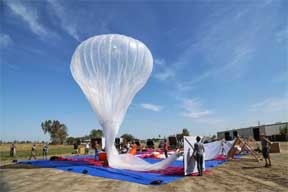After the Web-surfing glasses and
driverless car, Google has a new project up its sleeve.On June 15,
the US Internet giant unveiled its plans for a programme it has been
developing in its mysterious Google X lab. Called “Loon” (short for
“balloon”, but also a colloquialism meaning crazy person), the project
looks set to live up to its name.
To illustrate how the new project works, more than thirty
helium-inflated balloons were sent floating at roughly twelve miles
altitude in the sky above Christchurch, New Zealand (twice as high as
airplanes and well below satellites). Equipped with solar panels
generating electricity, the balloons are intended to bring the Internet
to regions that currently are not fully “connected” – particularly in
Africa and southeast Asia.
The “Loon” programme would also enable Web access to be speedily
re-established after natural disasters, like the 2011 earthquake that
killed 185 people in Christchurch.
The Internet speed offered by Loon “is equivalent to that of 3G
[third-generation high-speed network] and each balloon provides a
connection for the surrounding 40 kilometres”, specified Frenchman Johan
Mathe, one of the engineers in charge of the project.
The main challenge remains controlling the movement of the balloons
to protect them from the wind’s impact and make sure they reach the
targeted zones. Like Google’s search engine, the Loon balloons use
complex algorithms to determine their route, allowing them to change
altitude and find the winds that will bring them to their programmed
destination.
Growing the empire
Though only a few dozen balloons have been released into the New
Zealand sky for the moment, Google is planning on having as many as 300
circling the globe by the end of the year, bringing Internet access to
parts of Australia, South Africa and Argentina.
For the time being, Google has not specified how much money has been
invested in the Loon programme thus far or how much the company
anticipates spending on the programme’s expansion.
The uncontested king of online advertising, Google could further
expand its empire by promising to bring Internet to regions of the world
that have been largely offline until now.
Still, aside from financial considerations, the creation of a large
network of balloons would require special permission in order to be
launched in certain countries. In the US, for example, Google would have
to inform the Federal Aviation Administration for any launching or
landing of a balloon.
Google is reportedly already in contact with the equivalent agencies
in other countries in order to familiarise itself with the legal
requirements of such an operation.
Google has had success navigating legal hurdles for one of its other
innovations, the driverless car. In California, a bill authorising their
use has already been approved and signed by the state’s governor.
(FRANCE 24 with wires)
Source:
France 24



